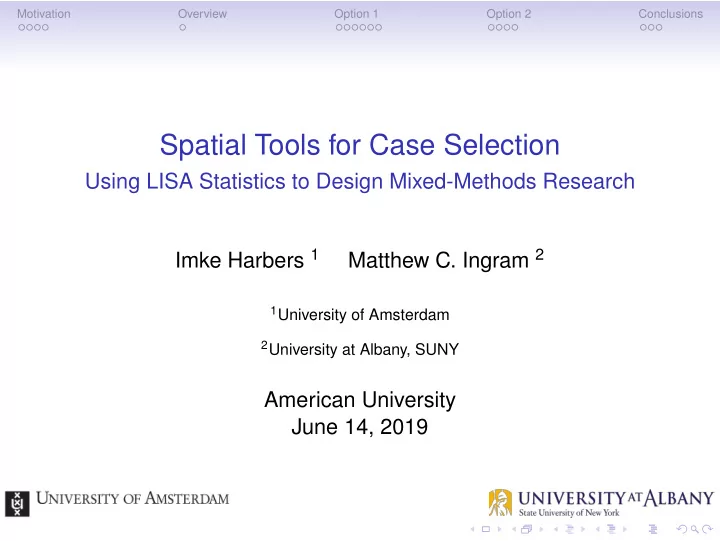

Motivation Overview Option 1 Option 2 Conclusions Spatial Tools for Case Selection Using LISA Statistics to Design Mixed-Methods Research Imke Harbers 1 Matthew C. Ingram 2 1 University of Amsterdam 2 University at Albany, SUNY American University June 14, 2019
Motivation Overview Option 1 Option 2 Conclusions Introduction Two Trends: (1) growing emphasis on mixed-methods designs (2) growing emphasis on interdependence, including geographic interdependence and on spatial analysis as a way to approach this interdependence Yet, little attention to mixed-methods research designs with spatially dependent data. Elsewhere, we have offered two strategies for doing this (Harbers & Ingram 2017, in Poliltical Analysis ) Here, we offer two case selection strategies to integrate (a) spatial statistics with (b) qualitative analysis.
Motivation Overview Option 1 Option 2 Conclusions Motivation: Analytic Issues 4 perspectives on spatial dependence: (1) Benign nuisance • know interdependence is out there, but not substantively interested in it and assume no meaningful impact (2) Threat to inference • know interdependence is out there, don’t have a substantive interest in it, but acknowledge that it undermines valid inferences, so account for it (3) Substantive interest • interdependence is a key feature of phenomenon of interest and theory, and want to test effects, e.g., diffusion (theory-testing approach in "Geo-Nested Analysis") (4) Substantive interest, but in theory-building mode (approach in this paper)
Motivation Overview Option 1 Option 2 Conclusions Motivation: Spatial Dependence as Given Interdependence inheres in social phenomena, and most social science data are likely spatial data. Outcomes we care about are clustered in space (e.g., voting).
Motivation Overview Option 1 Option 2 Conclusions Motivation Audience • Primarily mixed-method researchers, but also quantitative researchers working with spatial data Premises • Geography or context as placeholder for variables yet to be uncovered • Agnostic about reasons for spatial dependence Running example • County-level homicide rates in the US (Baller et al. 2001)
Motivation Overview Option 1 Option 2 Conclusions
Motivation Overview Option 1 Option 2 Conclusions Option 1 LISA statistics for outcome of interest . Identify clusters to visualize how an outcome of interest is distributed geographically, including how it maps onto existing boundaries, e.g., administrative, political, jurisdictional. Guiding questions : Is there clustering? How does the spatial association map onto political boundaries? What is the appropriate level of analysis for in-depth case studies? Do these patterns suggest scope conditions? Are there sites that stand out for one reason or another?
Motivation Overview Option 1 Option 2 Conclusions
Motivation Overview Option 1 Option 2 Conclusions
Motivation Overview Option 1 Option 2 Conclusions
Motivation Overview Option 1 Option 2 Conclusions Option 2 Assume have baseline, non-spatial model (e.g., OLS) and have extracted component that remains unexplained (residuals) LISA statistics (and maps) of residuals . Visualize spatially uneven performance of a model; identify high-high and low-low clusters to uncover omitted variables and scope conditions. Guiding questions : How does the model perform across space? Which regions of the study area are well predicted? Which are poorly predicted? Are there clusters of over- and under-prediction? Do these clusters map onto political boundaries?
Motivation Overview Option 1 Option 2 Conclusions
Motivation Overview Option 1 Option 2 Conclusions Conclusions Tools from spatial analysis can provide additional leverage for case selection. 1 Identify scope conditions 2 Clarify bound or unbound nature of phenomena 3 Examine causal mechanisms 4 Identify new, previously omitted variables, to generate new hypotheses and build theory Core implication across all proposed strategies: - need to redefine meaning of “case” as more than 1 unit of observation
Motivation Overview Option 1 Option 2 Conclusions Thank You
Motivation Overview Option 1 Option 2 Conclusions Spatial Tools for Case Selection Using LISA Statistics to Design Mixed-Methods Research Imke Harbers 1 Matthew C. Ingram 2 1 University of Amsterdam 2 University at Albany, SUNY American University June 14, 2019
Recommend
More recommend